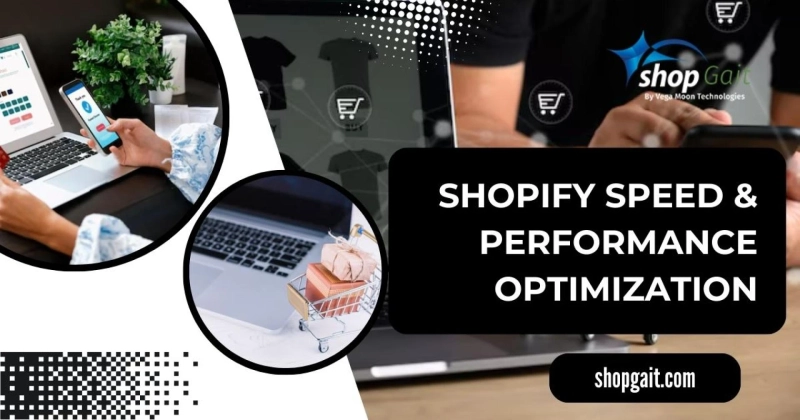When was the last time you waited more than a few seconds for a website to load? Chances are, you didn't stick around. Customers expect fast, seamless browsing. Visitors may abandon your site before purchasing if your Shopify store doesn't deliver. Shopify speed & performance optimization aren't nice add-ons for an eCommerce business; they are essential for boosting user experience and SEO rankings. This blog will walk you through actionable strategies for the Shopify Support & Maintenance Service to make your Shopify store lightning-fast, ensuring happier customers and higher conversions.
Why Shopify Speed & Performance Optimization Matters
User Experience: No one enjoys waiting for a slow-loading page. A website's load time directly impacts how long visitors stay and whether they proceed to purchase. Studies show that a one-second delay in loading can decrease customer satisfaction by 16% and reduce conversions by 7%.
SEO Rankings: Shopify speed isn't a user experience problem. Google considers page speed a ranking factor. Slower stores rank lower in search results, making it harder for potential customers to find you.
Revenue Impact: Faster websites lead to higher conversion rates. A Deloitte study found that for every 0.1-second improvement in site speed, average order values increased by 9.2%.
Thus, Shopify speed & performance optimization is critical for staying competitive in the crowded eCommerce landscape.
Analyzing Your Current Shopify Store Speed
The first step in Shopify speed & performance Optimization is understanding where you currently stand. Various tools can provide insights into how your site is performing and what needs improvement:
- Google PageSpeed Insights: Google PageSpeed Insights analyzes your site's speed on desktop and mobile and provides a performance score and actionable suggestions for improvement.
- GTmetrix: This tool offers an in-depth look at loading times, identifies slow-loading elements, and provides tips to enhance speed.
- Pingdom Website Speed Test: This tool measures load time and highlights the elements causing delays.
Image Optimization Techniques
Images are often the most significant web page assets and a common culprit behind slow load times. Here's how to do Shopify speed & performance optimization:
Compress Your Images
Compressed images keep most of their quality while using much less storage space. Free tools like TinyPNG or premium Shopify apps can compress images automatically.
Use the Right File Formats
Choose efficient image formats for your content:
- Use JPEG for standard images.
- Use PNG for transparent images.
- Use newer formats such as WebP for the best performance without sacrificing quality.
Implement Lazy Loading
Lazy loading ensures that images at the top of the page load first, while others load only when the user scrolls to them. This reduces initial load time and improves perceived speed.
Theme Optimization
Your Shopify theme plays a vital role in your store's performance. A poorly designed or overly complex theme can bog down your website.
Choose a Lightweight Theme
Opt for themes optimized for speed, such as Shopify's Dawn or other well-reviewed lightweight themes from the Shopify Theme Store.
Minimize Custom Code
Custom scripts or poorly written code can significantly slow down your website. Regularly audit your theme's code and remove unnecessary scripts. Shopify support & maintenance services often include custom coding audits if coding isn't your strength.
Regular Updates
Keep your current theme updated to ensure you use the fastest and most efficient version.
App Management
Apps extend the functionality of your Shopify support & maintenance Services, but too many can weigh down your site's speed. Follow these tips:
Audit and Remove Unnecessary Apps
Review your installed apps regularly. If an app's functionality isn't critical, consider removing it. Remember, even unused apps can leave behind leftover code that slows your site.
Consider Consolidating App Functions
Instead of relying on many apps for various tasks, choose multifunctional tools. For example, many Shopify apps combine SEO, analytics, and product description optimization.
Use Shopify API Integration Services
Integrating apps via Shopify's API can often be more efficient than relying on pre-built options. Consider consulting with professionals offering Shopify API integration services to streamline your store's operations.
Mobile Optimization
Over half of web traffic comes from mobile devices, making mobile optimization essential for any eCommerce business. Here's how to ensure your Shopify store performs well on handheld screens:
Ensure a Responsive Design
Choose a theme that automatically adapts to different screen sizes. Test your store on multiple devices to ensure consistency in user experience.
Simplify Mobile Navigation
Make it easy for mobile users to find what they're looking for. Use a clean design and ensure your call-to-action buttons are thumb-friendly.
Reduce Mobile Load Times
Compress images for mobile, minimize unnecessary elements, and avoid using heavy pop-ups that disrupt the browsing experience.
Shopify Speed & Performance Optimization
Shopify speed & performance optimization is not a one-time job. To ensure your Shopify store continues to perform at its best, follow these maintenance tips:
- Monitor Regularly: Use Google PageSpeed Insights or similar tools monthly to check your site's health.
- Update Content and Features: Periodically update or remove outdated products, pages, and apps.
- Educate Your Team: If multiple team members manage your store, ensure they understand the importance of speed and how their updates may impact performance.
Consider outsourcing to professional Shopify support & maintenance services to keep your store running smoothly without increasing your workload.
A Fast Store Equals Happy Customers
Shopify speed & performance optimization isn't technical; they invest in customer satisfaction and your business's bottom line. Slow speeds can reduce conversion rates, increase bounce rates, and damage your SEO. Following the above strategies can create a seamless online shopping experience that builds customer loyalty and grows your revenue.
If you need expert help optimizing your Shopify store, exploring Shopify support & maintenance services or Shopify API Integration Service can save time and eliminate guesswork. A faster store isn't a competitive advantage; it's necessary in today's eCommerce environment.



